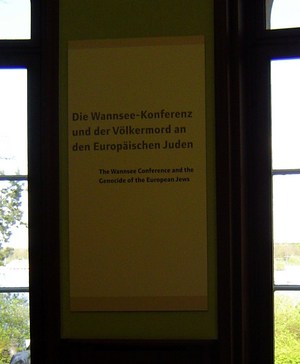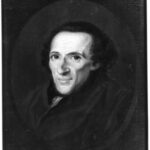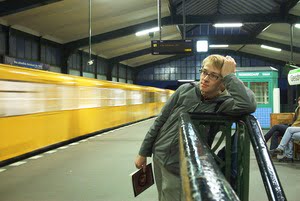South of Berlin, on a beautiful lake, stands the villa that became the meeting place for fifteen high-ranking Nazi officials to discuss what would become the Final Solution to the Jewish Question. Today, the meeting is referred to as the “Wannsee Conference.” The purpose of the conference was to plan the deportation and murder of the entire population of European Jews.
The efficiency of the Germans and their meticulous recordkeeping has left us with documents that describe in detail the plan to murder all European Jews. The site of the meeting has been transformed into a permanent exhibition and library/media center where visitors and researchers can find information on a variety of subjects related to the Holocaust. A large part of the library’s collection is in languages other than German.
The exhibition, entitled “The Wannsee Conference and the Genocide of the European Jews”, documents the Nazi persecution of the Jews, the process of excluding them from German society, the events of 1933-1939 when the Jews were expelled and deprived of their rights, the deportations, the ghettos, and finally, the death camps (Wannsee Conference Memorial).
The meeting to determine the Final Solution to the Jewish Question was held on January 20, 1942, and was chaired by Reinhard Heydrich, head of the Reich Security Main Office. Adolf Eichmann recorded the minutes of the meeting. The minutes or “protocol” was found in 1947 in the foreign ministry files and translated for use as evidence in trials at Nuremberg. In the protocol, the participants talk about the steps needed to rid Europe of all Jews. Estimates put the European Jewish population at about 11 million.
The meeting began with an outline of what had been done so far to rid Germany of Jews. Primarily, Jews had been deported or allowed to immigrate to other countries. Some had been rounded up and shot. These were inefficient ways of dealing with the problem, so a special office was set up in 1939 with the purpose of speeding up the process. “The aim of all this was to cleanse German living space of Jews in a legal manner.” (The Wannsee Protocol) The problem was that those countries that were the recipients of these immigrants were getting harder to deal with. Therefore, it became necessary to devise a permanent solution to the Jewish problem.
The first step would be to transport all able-bodied Jews to Eastern Europe to work on roads “…in the course of which action doubtless a large portion will be eliminated by natural causes.” Then a solution would need to be developed to deal with those who survived hard labor. The possible final remnant will, since it will undoubtedly consist of the most resistant portion, have to be treated accordingly, because it is the product of natural selection and would, if released, act as a the seed of a new Jewish revival.” (Wannsee Protocol)
The plan was to send the Jews to transit areas before sending them to the East. These were the “ghettos.” Those persons over age 65, severely wounded veterans and Jews with war decorations would go to a special ghetto for the aged. The meeting also included a discussion which would outline the prerequisites for the final solution of the problem of mixed marriages and persons of mixed blood. The Germans defined mixed blood as mixed Jewish and German.
For many years after World War II, the Germans tried to avoid dealing with the atrocities of Adolf Hitler. In recent years, there has been a move to educate, discuss and remember as a way of making sure that it never happens again. Germans have hesitated to create “memorials” to past history fearing that these landmarks will become a shrine to the perpetrators of the crimes against humanity.
In a brief period of time, only ninety minutes, the course of Jewish history changed forever. By the end of World War II, the Germans had systematically murdered one-half of the European Jewish population. Looking across the back lawn of the villa towards a lake dotted with sailboats, the area seems like an unlikely setting for such a meeting. Possibly, the setting is symbolic of the casual attitude that the Nazis had towards genocide. For most of its participants it was just one meeting among many others in a busy week.
Sources
House of the Wannsee Conference Memorial and Educational Site
John Mendelsohn, ed., The Holocaust: Selected Documents in Eighteen Volumes. Vol. 11: The Wannsee Protocol and a 1944 Report on Auschwitz by the Office of Strategic Services (New York: Garland, 1982), 18-32.







